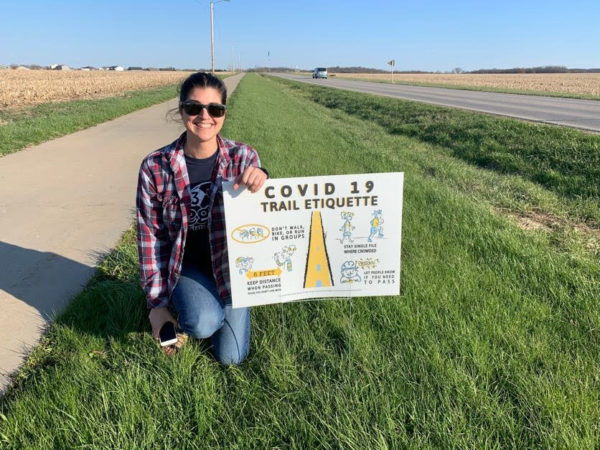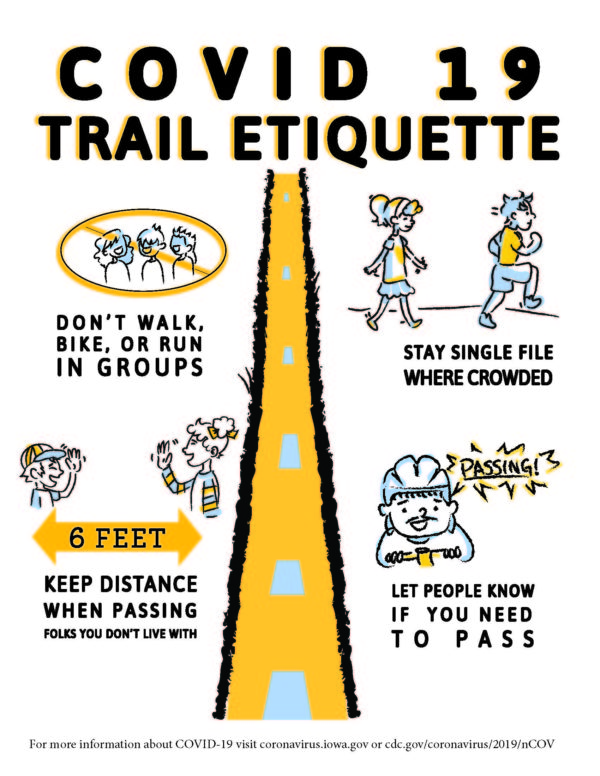Breadcrumb
Student project builds awareness of social distancing etiquette in outdoor spaces
Published on May 6, 2020
Anne Abbott is a PhD student in community and behavioral health at the University of Iowa College of Public Health. Her research is focused on health communication campaigns, adolescent and young adult health, and program evaluation.
Several weeks ago, Anne began a collaboration with local parks and recreation departments to produce materials that build awareness of social distancing etiquette while using outdoor public spaces during the COVID-19 pandemic. These materials are free and available for anyone to download.

Q: Give us a little background on the project.
A: This project focuses on specific ways that individuals can socially distance while they are using outdoor spaces like parks, trails, and sidewalks. A group of students and others from the college reviewed the research on how respiratory viruses spread, developed the messages, and worked with a designer to create the materials. We are now disseminating the files for groups that want to encourage social distancing in their communities.
Q: What led you to get involved?
A: As places like schools and businesses started to shut down due to COVID-19, I started noticing a lot more people using the park and trails near my home. On one hand this was great; more people getting physical activity and more people out enjoying nature is great for human health. However, as the park/trails/sidewalks started getting more use, I noticed people were not following the CDC’s recommendations about six feet of social distancing. It seemed like a lot of this was just folks not understanding what social distancing meant. This is something you see a lot in public health messaging—message designers give a vague behavioral recommendation and fail to say how to engage in a behavior. Particularly for something like social distancing that needs to be done in a wide range of situations and settings, this lack of specific guidance can lead to a lack of what public health folks call “behavioral uptake.” It seemed like there was a gap in the messaging, and in talking with other public health colleagues they agreed, so we wanted to fill that gap.
Q: What types of information and materials are available?
A: We have a variety of files anyone can download on the Prevention Research Center for Rural Health’s website. The materials are most appropriate for outdoor spaces like parks and trails, but we have had some interest in neighborhood groups using them on busy sidewalks. There are several 8.5” x 11” sized sign files that people can print on a regular printer and then decide where in parks, neighborhoods, or trails they’d like to put them. We also have an Implementation Guide to help people decide how best to use them. The signs focus on a range of behaviors that help people socially distance while they are outside.
We also have two yard-sign sized signs that are great for park entrances, trail heads, or even along trails where a larger sized sign might be easier to see. The PRC has also printed a few hundred of the “Trail Etiquette” yard signs for groups that do not have the budget for printing their own yard signs. Groups that are interested in getting some of those signs free of charge can contact me about details (anne-abbott@uiowa.edu). We also have options for getting more printed through a local printer.
While the messages were designed to serve as cues to action in public spaces, we also have a few social media images as well. The images are best used on Facebook because it has the fewest formatting requirements. Social media posts are great for getting people to think about a behavior before they need to do it, so running or biking groups, youth groups or organizations, and others might like to use these to communicate with their audiences about staying healthy outside!
 Q: Is there an evaluation component to the project?
Q: Is there an evaluation component to the project?
A: There are definitely some basic evaluation metrics I want to look at—things like the number of entities (towns, cities, trail commissions, etc.) that end up using the signs, and at some point I’d love to do some interviews with the sites about what worked and what didn’t.
I also never really got to pre-test the messages because things moved so fast with the shutdowns, and I just wanted the messages to get out. This is not really “best practice,” so I would love to do some focus grouping to get some actual feedback from audience members.
With every message there are going to be people who like it and want to engage in the behavior because of it, and then people who don’t like it and either ignore your message or, worse yet, engage in the opposite of what you asked them to (the boomerang effect). These messages were designed not to be offensive or super preachy, but it would still be great to get a more formal record of peoples’ reactions to them.
Q: What sort of response has there been to the materials created?
A: So far it’s been great! We have had a lot of statewide groups tell us how thankful they are for the materials and how much they think they are needed. Groups like the Healthiest State Initiative, the Iowa Cancer Consortium, the Iowa Parks Foundation, the Iowa Public Health Association, and others have helped us get the word out.
We’ve had a lot of different jurisdictions take this on too, and each does it a little differently based on what works for them. North Liberty, Iowa, in particular has done a great job. They came right out of the gate with getting some signage posted, followed up with some social media posts, and got some earned media for their efforts.
Benton County Conservation is another group that has been really great. They didn’t have a budget for printing, but they got that signage up anyway! Public health requires this kind of creativity and it’s great to see it in action!
I also want to mention the Lamoni Trail Commission. They actually secured a partnership with a local business to get some signage up on their trails and also followed up with social media! These are groups that even in regular times operate on a shoe string, but they are finding ways to keep folks healthy and it is great to work with them!
I also have a number of groups that are waiting on printing but are planning to implement. I will be so excited to see what they do (shout outs to West Branch, Wapello County, and Hiawatha who I heard from yesterday)!
Q: How can other organizations access the materials?
A: We currently have all the files posted up on the University of Iowa PRC website, and the Iowa Parks Foundation was also kind enough to post them on their website for us. For folks interested in getting some of the “Trail Etiquette” yard signs or have questions about how to make this work in their community or for their group, they can get into contact with me directly at anne-abbott@uiowa.edu. I love to hear about communities using the materials, so if you are already using them you can also feel free to email me a pic or a video!